Eltham Copper Butterflies (ECB) Currently occur in three small remnant patches of vegetation in the Wimmera: Kiata, Wail and Gerang Gerung. Salisbury used to support ECB but this population is now confirmed as being extinct. All three remnant ECB populations are isolated from each other by a sea of agriculture with no way for butterflies to travel between populations to exchange genetic material and move around as resources vary seasonally. This means all three poplulatinos are at risk of extinction from weed, pest invasion, threatening events like fire, drought etc and genetic inbreeding. In addition there are undoubtably other small remnants where ECB exist in the Wimmera, but they are unknown to us. Finding new populations increases the chance that this species will exist into the future. By protecting ECB we also protect the many other rare and threatened plants, animals and insects that exist in these rare and precious remnants.
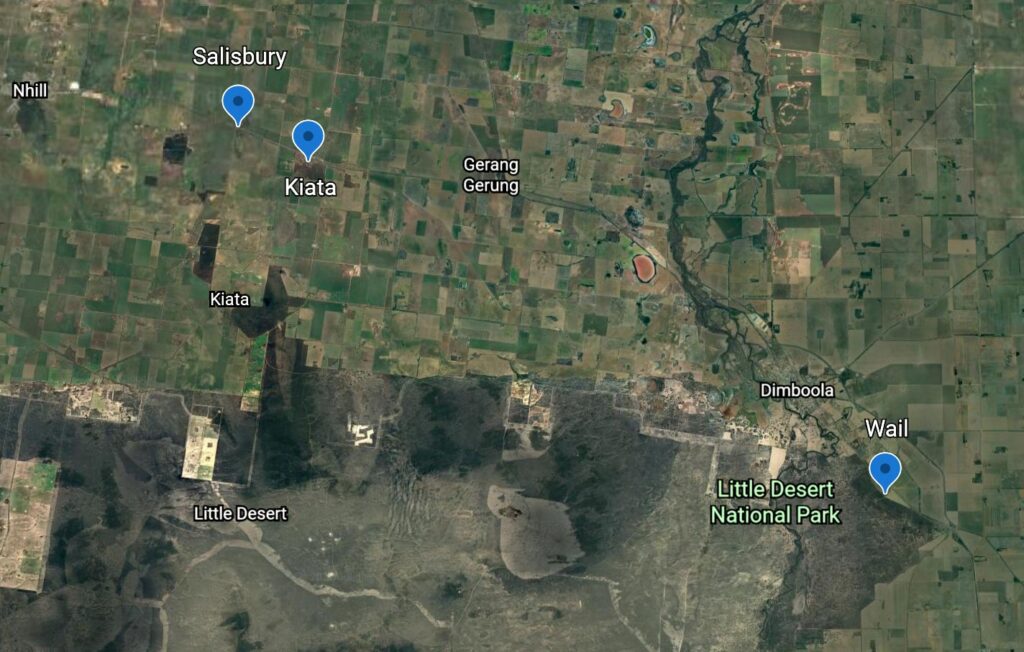
Finding where a rare species occurs is the first step in conserving it, protecting them from threats is the next. Sadly since 1988 many populations have been lost, including the recently discovered one in Salisbury (last seen in 1994). The Salisbury population is now considered extinct most likely from sheep grazing and the resultant loss of the butterfly host plant and other flowering food plants.
An unknown number have been lost from areas where they had yet to be discovered. For example analysis of museum specimens showed that ECB was in Dimboola in 1907. However bursts of effort over the decades has led to the discovery of new populations, mostly in North Central Victoria (Bayes, et al., 2012), but also from a roadside in Wail State Forest in 2012 by Fabian Douglas (Douglas, 2012).
No formal surveys have been undertaken at these sites since this time. The area and condition of ECB habitat at known locations is unknown. Management activities have been minimal with some Bursaria planting and exclusion fencing at Kiata in 2009. Suggested managment actions have been detailed in the Management Section.
Mapping Sweet Bursaria and Searching for new ECB populations in the Wimmera 2020-2023
Wetland Revival Trust (WRT), an environmental charity, received funding in 2020-2023 through the Victorian Government’s Biodiversity Onground Action Program. The aims of the project were to map Sweet Bursaria (ECB sole larval food plant) and adult ECB at Kiata, Salisbury and Wail and estimate population size. A second aim was to search for ECB in new locations, by mapping presence and density of Bursaria spinosa denisty as a surrogatefor ECB habitat (this method was trialed at Kalimna Park Castlemaine, 97% of ECB sightings were in grids with 20-50 Sweet Bursaria plants).
The Sweet Bursaria mapping and ECB adult mapping at Kiata, Salisbury and Wail showed that of the 90ha Kiata Reserve, only 6 ha had Bursaria spinosa, and only one hectare of Salisbury had Sweet Bursaria out of the 12ha. Wail roadise is a 50m by 400m strip of roadside but supports over 100 ECB. There are no or few Sweet Bursaria plants to the north or south of the Wail poplation for ECB to move to or to share genetic material with other populations.
In the search for new ECB populations, in 2021-2023 WRT found a healthy ECB population at Gerang Gerung. This is an exciting find which is being more rigorously mapped in the summer of 2022-23. These ECB searches are funded by DELWP ICON SPECIES Grant and will continue this summer of 2022/23.
Both Kiata and Wail are small and vulnerable to threats. These two Wimmera populations are genetically isolated from each other and from their nearest relatives to the south, which is Bendigo. This may lead to genetic drift and loss of these populations.
ECB and other species with highly specialised requirements and poor dispersal rates are highly vulnerable to extinction when their habitat patches are small and dispersed in a sea of agriculture/development (called fragmentation). Fragmentation results in loss of resources for ECB, and the ant species they depend on, Notoncus requirements. The smaller the remnant vegetation patch, the fewer the Sweet Bursria plants and other flowering plants the area can support. There is an overall loss of biodiversity (and abundance) as patch gets smaller. This results in a decreased area for a species to persist and creates a barrier for species to move between patches to share genetic material and find new resources.
Current ECB area and numbers in the Wimmera are shown in Table below.
| Wimmera | Date discovered | Total Areas of High/Med Bursaria Density (Area of reserve) | 2021/22 ECB numbers (past max no. recorded |
| Kiata | 1988, extended 2022 | 6 ha (113 ha reserve) | 56 (2000) |
| Wail Reserve Road Roadside | 2011, extended 2022 | 3.5 (6) | 122 (62) |
| Salisbury | 1988 | 1 ha (16 ha) | 0 (4) |
| Gerang Gerung Mallee Dam | 2022 | 46 (118) | To be determined in 2022/23 |
| Gerang Gerung North Reserve | 2022 | 58 (128) | To be determined in 2022/23 |
| Gerang Gerung South Reserve | 2022 | 35 (62) | To be determined in 2022/23 |
Salisbury

In 1987 one ECB was observed by Pat Vaughan in Salisbury Bushland Reserve, he also noted that there were 220 Sweet Bursaria Plants and that the area was grazed by sheep and the vegetation was greatly modified with little understorey (Vaughan, 1988). In 1993-1995 Bev Van Praagh observed a maximum of 4 ECB in 1993 in the SW corner of the reserve and none in 1994 (Van Praagh, 1996).
There are only two ECB records since this time on the Victorian Biodiversity Database (VBA) which are listed as being seen by staff from DEWLP Horsham in 2005, however they do not recall this record (pers comm August 2021). ECB surveys carried out in 2011 and in the summer of 2021-22 indicate there are no ECB in this location. Dense areas of Sweet Bursaria occur in one hectare and there are scattered plants in a further 2.75 ha. Around 40 Sweet Bursaria occur in the SW corner of the reserve which are surrounded by a pest proof fence.
This population is assumed extinct.

Kiata Flora Reserve ECB
Early documented records of ECB at Kiata were given by Crosby (1951, 1965), Tindale (1953) and McCubbin (1971), although the population was known to exist since 1930’s (K. Hateley, pers comm 1987) (Braby, Crosby, & Vaughan, 1992). There were no ECB records for 31 years until 1987 when Pat Vaughan located 5 new discrete populations of ECB at Kiata (Vaughan, 1988).
Historically Kiata was referred to as being 90ha in area and that there were 4 or 5 sub-populations scattered throughout the park, one of which is outside the park and on the roadside (Van Praagh, 1996) (Vaughn, P.J, 1988). WEtland Revival Trust Bursaria mapping in 2021 showed that of the 90ha there are only 6 ha which support dense patches of Sweet Bursaria and 12 ha that support any. The mapping also found that there were two newly discovered Bursria patches in the NE and SE corner of the park that had never been surveyed. Follow up ECB searches in Bursaria grids found that the SE corner did support ECB.
Given the uncertainty around how far ECB travel (current belief is <200m), the clustered distriubution of Bursaria and therefore ECB throughout the park may mean that some sub-populations are isolated from one another.
The maximum number of ECB seen at Kiata during the summer of 2021/2022 surveys was fifty-six (see Table below).
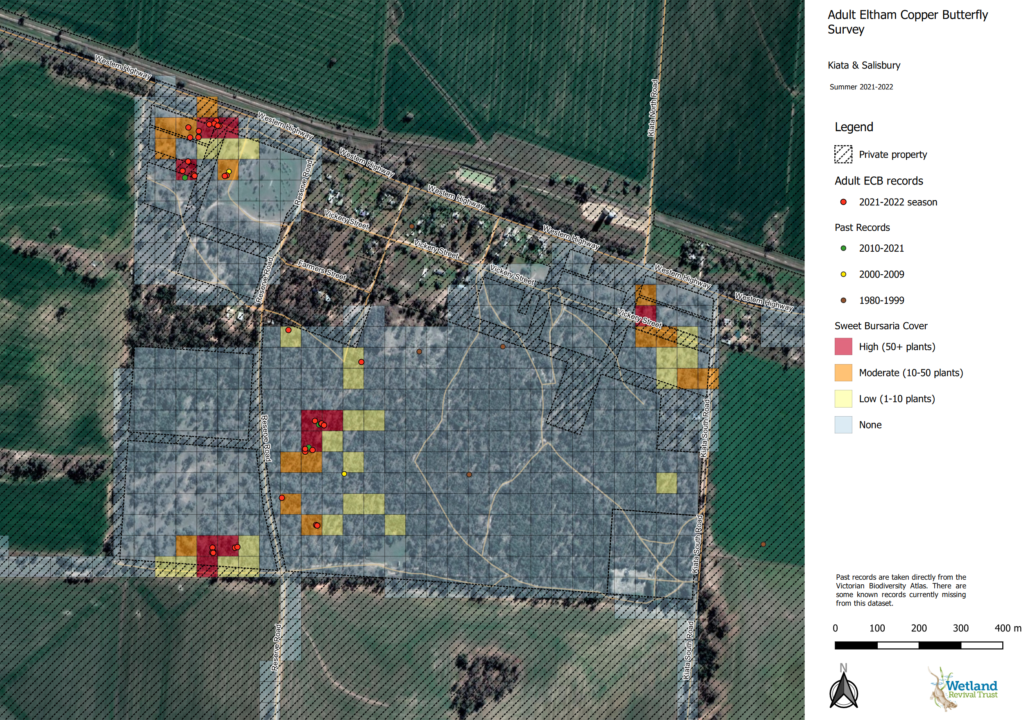
Fabian Douglas in his 2012 report noted that ‘two males that were photographed at ‘Site A 1’ and ‘Site A 3’ exhibited a similar abnormality in their hindwing underside markings. Fabian (2012) stated that this may indicate that a genetic bottleneck in P. p. lucida has occurred at Kiata in recent years.
There is a pest (rabbits and hare) exclusion fence around some of the ECB colonies at Kiata erected 20 years ago by previous departmental staff and working with locals (pers comm, Glenn Rudolph Aug 2021). Glenn recalls that DELWP did a lot of survey work from 2008 to 2010. Andrea Canzano also carried out research and counts at Kiata (Canzano unpublished). Both these data sets are currently unable to be located.
One of the five sub-populations is close to the Western Highway. This is an important site as it supports around 200 ECB (Canzano, unpublished). This population also has a dirt road running through the centre of the population. It is therefore critical that this area is promoted to local road and associated works by power suppliers etc. local awareness of this population.
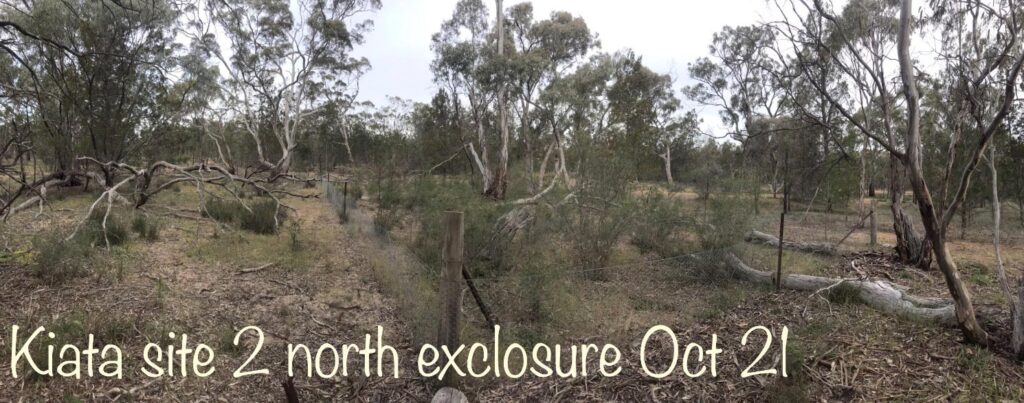
At Kiata Pat Vaughan described the habitat as occurring on flat to very gently sloping ground with an overstory of very open woodland of Buloke, Slender Cypress Pine and Black Box. Sweet Bursaria grows in discrete patches. Native grasses, mosses, lilies and pigface dominate the ground layer. Other species present include Cherry Ballart, Flame Heath, Grey Mulga, Golden Wattle, Desert Hakea, Matt Rush and Hop Bush (Vaughan, 1988).
Wail ECB Population
The Wail ECB population was discovered by Fabian Douglas in 2011 on a 50m wide roadside in Nursery Road (Douglas, 2012). No further monitoring or management actions occurred at this site since this time. WRT received a DELWP ICON species grant in 2021-2022 which funded Bursaria mapping and follow up ECB surveys at this site.
Bursaria Mapping in 2021 and 2022 (Figure below) showed that the Wail ECB population extends a further 500m north than where they were originally found. The total area of this population was mapped as around 4 ha and a max of 122 ECB were observed in summer of 20212/22. Although a small area this is a significant number of ECB compared to most Victorian ECB populations.
Bursaria mapping was conducted in the land surrounding the Wail population. Figures below show that there is no significant habitat (presence of larval host plant Bursaria spinosa) to the north or south of the Wail population which will support this species.
This Wail population is on a 50m by 400m stretch or roadside, sandwiched between the road and a plantation. This makes it highly vulnerable to road and roadside works. It is critical that management actions are undertaken to raise awareness of this small area but significant ECB population. This site was recently sprayed for bridal creeper and Bursaria plants were damaged. It is therefore critical that this area is promoted to local road and associated works by power suppliers etc. local awareness of this population.
Expanding the ECB habitat by planting more Bursaria spinosa and other ECB supporting species would be beneficial to the longevity of this population and introducing new genetic material given how isolated this site is.


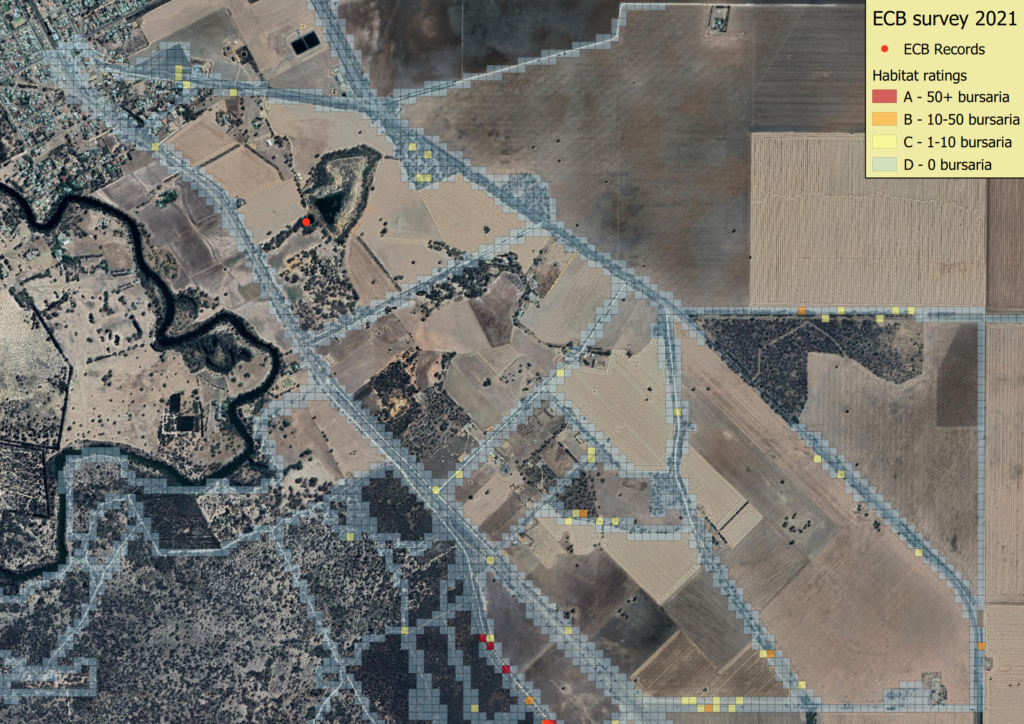
ECB habitat mapping to the north of the Wail population indicates no dense Bursaria spinosa patches to support ECB
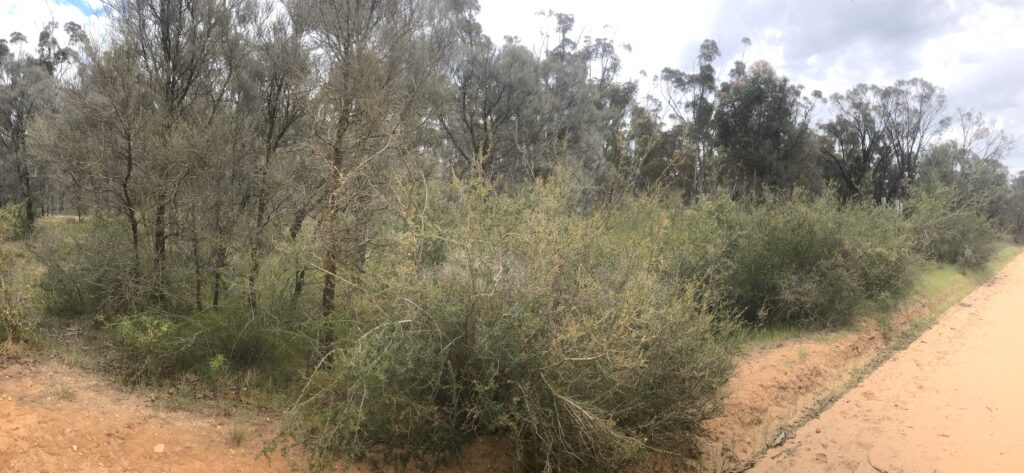
Photo of Wail, restricted to 50m x 400m on roadside with agriculture to the east and a plantation to the west.